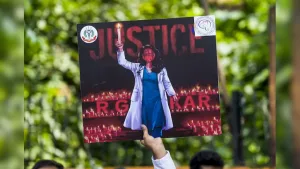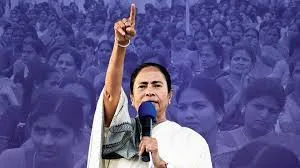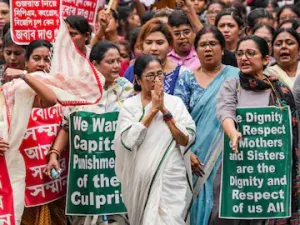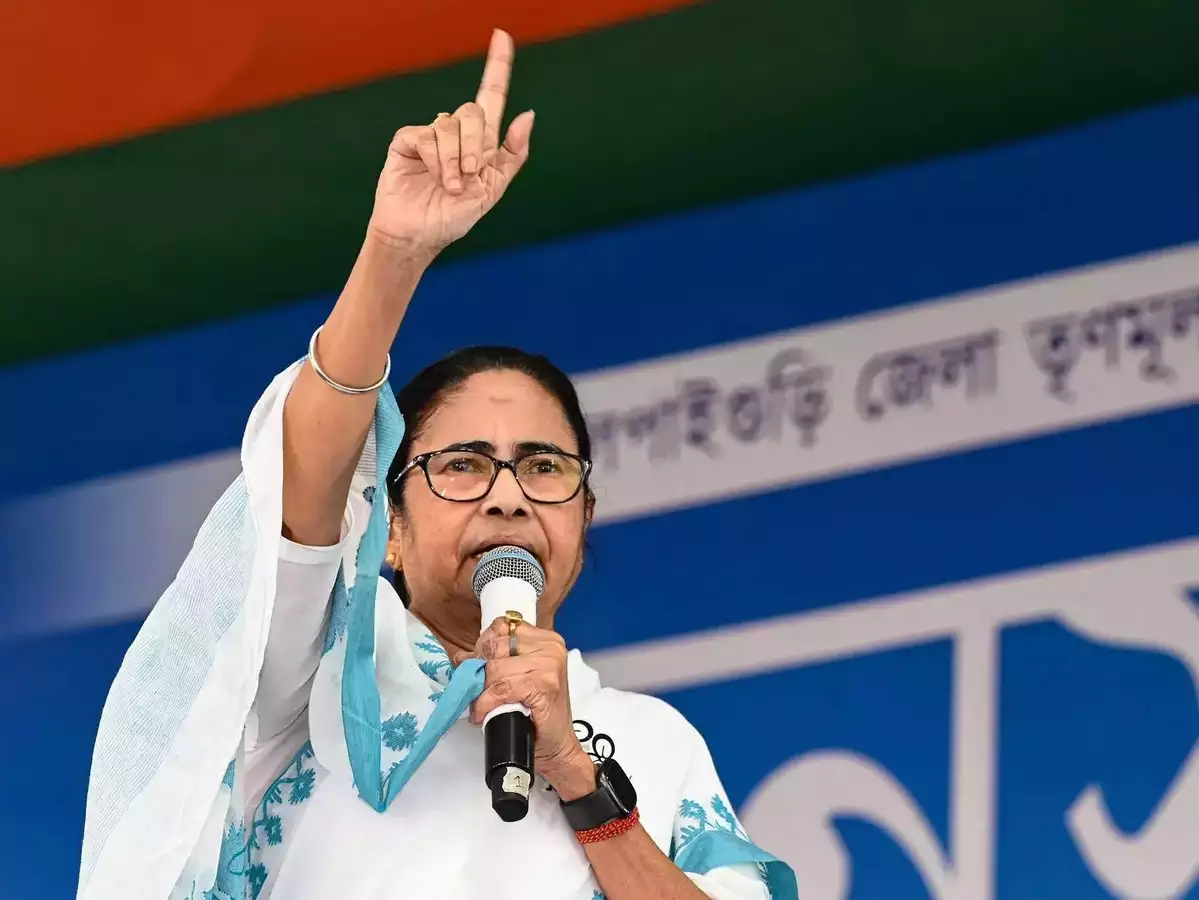As one of India’s longest-serving female Chief Ministers, Mamata Banerjee has undeniably carved a place for herself in the political landscape of West Bengal and the nation. Banerjee’s initial struggle as a woman representative not only brought her to power but also opened the doors for other women to rise in the ranks within her party, the Trinamool Congress. Despite critics lauding her women-centric schemes, with promises of upliftment, financial support and security for women, the reality on the ground tells a more complex story.
While women lawmakers from her party have gained prominence, the stark contrast between the progressive promises and the on-the-ground realities for women—ranging from rising crime rates to socio-economic challenges—raises critical questions about the true impact of her policies.
The election commission’s statistics for 2021 indicated a record female voter turnout of 81.7%, surpassing the state’s overall turnout. This highlights women voters as a crucial and decisive force in the state’s policy decisions. The question remains: Did the state effectively address women’s issues or did the Mamata Banerjee government resort to populism?
Women-Centric Policies: Vision and Decrepit Implementation
Notable flagship programs initiated by Mamata Banerjee under the TMC government are Kanyashree, Rupashree and Lakshmir Bhandar, among others. These initiatives aim to reduce child marriages, provide financial support to families and enhance social security for women.
One such programme that gained much prominence was Kanyashree, which offers financial benefits to girls so as to remain in school and postpone marriage. However, the policy has been criticised for bureaucratic inefficiencies not letting the programme function properly, along with delayed fund disbursement and lack of reach in rural and remote areas.
Currently, 49.9% of girls aged 15-24 in the state do not attend school, compared to 43.8% nationwide. This statistic reveals systemic issues in the implementation of the Kanyashree scheme.
According to reports, disbursements under Kanyashree have been delayed in several districts, leaving many girls without the promised financial aid. Moreover, a lack of awareness about the program in remote areas has led to lower participation rates.
Moreover, the National Family Health Survey (NFHS-5) report indicates that in 2022, the percentage of girls married before the age of 18 remained at 41.6%. This issue is more pronounced in rural areas, where the figure is 48.1%, compared to 26.2% in urban areas. Additionally, this percentage shows little change from the NFHS-4 report from 2015-16.
An educationist Dr Suman Dey noted, “Kanyashree has been successful in cities. Its reach is, however, confined to pockets. People are not aware of how to go about these schemes and, even if they know how, bureaucratic hassles still await them. An all-pervasive lack of information pertaining to government schemes targeting women’s empowerment further complicates things.”
Moreover, Banerjee’s populist approach is evident in her strategic use of these schemes to secure votes. By focusing on immediate, tangible benefits, she has managed to create a loyal voter base among women. This strategy has been effective in countering opposition parties, particularly the Bharatiya Janata Party (BJP), which has struggled to make significant inroads in West Bengal
Violence Against Women: An Unaddressed Crisis

The government may boast of its performance, but violence against women is still a major issue in West Bengal. Reports of rapes, dowry deaths, molestations and other forms of violence against women are disturbingly high. The National Crime Records Bureau (NCRB) consistently ranks West Bengal among the states with the highest number of reported dowry deaths and cases of sexual harassment. In 2021, according to the NCRB, West Bengal recorded the highest number of sexual harassment cases in India, exceeding 10,000 incidents, along with 322 dowry deaths.
Recent incidents, such as the Sandeshkhali sexual harassment case and the RG Kar Hospital tragedy, have pointed out these very issues. In Sandeshkhali, the case of rape and violence triggered outrage at large, while critics point out that the state government underplayed the matter by ascribing it to the rivalry between political parties. Critics have attacked the state’s inability to safeguard women and punish criminals severely. For instance, Sumedha Kaushal, a human rights lawyer, said, “Mamata Banerjee’s administration has failed to take a strong stand against violence, and its silence has been deafening.”
Moreover, the government’s unwillingness to empower police forces for better response in such cases has raised grave doubts. Women from rural areas complain of harassment or complete indifference from the police on their complaint registration efforts. The inadequacy of speedy courts and delayed operationalisation of POCSO courts for speeding up sexual offence cases have aggravated the situation.
In a recent reply to Mamata Banerjee’s letter requesting the establishment of fast-track courts, the central government stated that none of the 123 fast-track courts, which include 20 exclusive POCSO courts, provided were operational until June 2023. The government also emphasised that the West Bengal government needs to take action regarding their functioning, as approximately 48,600 rape and POCSO cases are pending in the state.
Economic Policies Or a Fallacy?
Mamata Banerjee’s economic policies towards women empowerment, like promoting self-help groups and microfinance loans, have not been very successful despite ensuring women at least gain some financial assistance. Most of the microfinance schemes have been criticised for providing petty loans that do not generate any long-term financial freedom. With no large-scale industry-driven women employment generation programs, the gap for economic empowerment has been wide.
High unemployment among women remains one of the major problems as compared to the national average. In 2022, the International Labour Organisation reported that women’s participation in the workforce in the state was just 17.67%, significantly lower than the national average of 25.22%. Currently, 58% of young women in the state are neither employed nor pursuing education or training. This situation puts them at risk of falling below the poverty line, as they are excluded from the job market and lack the skills needed to improve their economic circumstances.
Dr Arvind Sharma, an economist, said, “The government focus on education and marriage delay is important, but the long-term impact of these schemes remains limited without employment or entrepreneurship opportunities for women.”
Banerjee’s populist approach is evident in how she strategically utilises various schemes to secure votes. By concentrating on immediate and tangible benefits, she has successfully built a loyal voter base among women. This strategy has proven effective in countering opposition parties, especially the BJP, which has had difficulty making significant inroads in West Bengal.
Healthcare and Maternal Mortality
Maternal health is another area that has failed to meet the expectations of the state’s women-centric policies. The commitment of the state towards the welfare of women has seen maternal mortality remain above the national average in West Bengal. The absence of basic healthcare infrastructure and obstetric care at the opportune time in rural areas keeps affecting the health index of women. Maternal mortality in the state according to the NFHS has stood at around 160 deaths per 100,000 live births against the national average of 113.
The failure to address basic healthcare needs for women is another sign of the government’s lack of a comprehensive vision for women’s welfare.
Political Favouritism Tramples Women’s Empowerment

One of the most severe points of criticism against Mamata Banerjee’s governance policies is the perception of unequal application of these policies – that is, it sometimes discriminates against regions of their implementation where TMC has no strong base of operation. Critics further observe that women in opposition-held territories are often deprived of the government schemes, ostensibly for fear of not being ‘in line’ with the ruling dispensation.
“The government’s rhetoric of women’s empowerment is diluted by its political agenda,” said political analyst Rina Das. “The schemes are often used to consolidate support in areas where the TMC is struggling. This kind of selective implementation undermines the integrity of the programs.”
Women now doubt the credibility of Mamata Banerjee to protect their rights. Organisations at the grassroots level and women’s collectives have lately united for their grievances against the government for their failure in proper implementation and execution of their welfare measures.
The BJP and CPI(M) have capitalised on this disappointment by presenting themselves as much better options for women’s empowerment. “While Mamata talks about empowering women, her government’s record says otherwise. Women are not yet safe and all promises of economic upliftments are still left unfulfilled,” said a BJP leader.
A Difficult Inheritance

With increasing discontent among the female voters, the Mamata Banerjee government is feeling the strain to turn rhetoric into more concrete and permanent change. Women’s welfare is going to be an important battleground for West Bengal politics in the upcoming election.
The spiking of violence against women calls for immediate attention. Ensuring the creation of specific women’s police units and fast-track courts, and improving the police’s responsiveness would ensure quick justice. According to Kaushal, “Women should feel safe to report crimes, and the justice system must act quickly.” Ensuring digital access with decentralised distribution via panchayats would ensure that everyone benefits. Sharma said, “A digital transformation could revolutionise scheme distribution, making it politically neutral and accessible.”
To address the high unemployment rate among women, Mamata’s government needs to invest in skill development programs, promote women’s entrepreneurship through micro-loans and encourage women’s participation in emerging sectors like technology.
Strengthening rural health infrastructure and introducing mobile health clinics would reduce maternal mortality and promote better access to healthcare facilities. Health professional Dr Malini Joshi said, “Quality care to reach rural women both through improved infrastructure and adequate personnel.”



